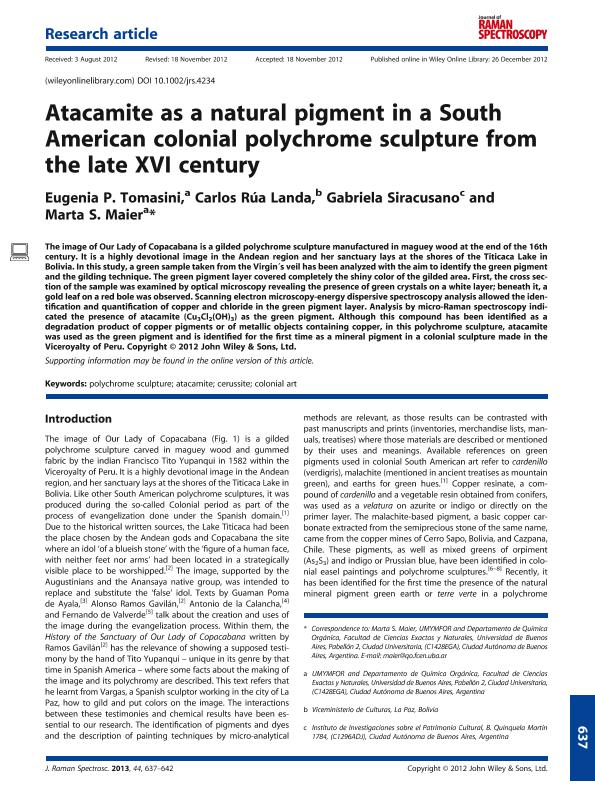Artículo
Atacamite as a natural pigment in a South American colonial polychrome sculpture from the late XVI century
Fecha de publicación:
12/2012
Editorial:
Wiley
Revista:
Journal Of Raman Spectroscopy
ISSN:
0377-0486
Idioma:
Inglés
Tipo de recurso:
Artículo publicado
Clasificación temática:
Resumen
The image of Our Lady of Copacabana is a gilded polychrome sculpture manufactured in maguey wood at the end of the 16th century. It is a highly devotional image in the Andean region and her sanctuary lays at the shores of the Titicaca Lake in Bolivia. In this study, a green sample taken from the Virgin´s veil has been analyzed with the aim to identify the green pigment and the gilding technique. The green pigment layer covered completely the shiny color of the gilded area. First, the cross section of the sample was examined by optical microscopy revealing the presence of green crystals on a white layer; beneath it, a gold leaf on a red bole was observed. Scanning electron microscopy-energy dispersive spectroscopy analysis allowed the identification and quantification of copper and chloride in the green pigment layer. Analysis by micro-Raman spectroscopy indicated the presence of atacamite (Cu3Cl2(OH)3) as the green pigment. Although this compound has been identified as a degradation product of copper pigments or of metallic objects containing copper, in this polychrome sculpture, atacamite was used as the green pigment and is identified for the first time as a mineral pigment in a colonial sculpture made in the Viceroyalty of Peru.
Palabras clave:
Polychrome
,
Sculpture
,
Atacamite
,
Cerussite
Archivos asociados
Licencia
Identificadores
Colecciones
Articulos(SEDE CENTRAL)
Articulos de SEDE CENTRAL
Articulos de SEDE CENTRAL
Articulos(UMYMFOR)
Articulos de UNID.MICROANAL.Y MET.FISICOS EN QUIM.ORG.(I)
Articulos de UNID.MICROANAL.Y MET.FISICOS EN QUIM.ORG.(I)
Citación
Tomasini, Eugenia Paula; Rúa Landa, Carlos; Siracusano, Gabriela Silvana; Maier, Marta Silvia; Atacamite as a natural pigment in a South American colonial polychrome sculpture from the late XVI century; Wiley; Journal Of Raman Spectroscopy; 44; 4; 12-2012; 637-642
Compartir
Altmétricas




